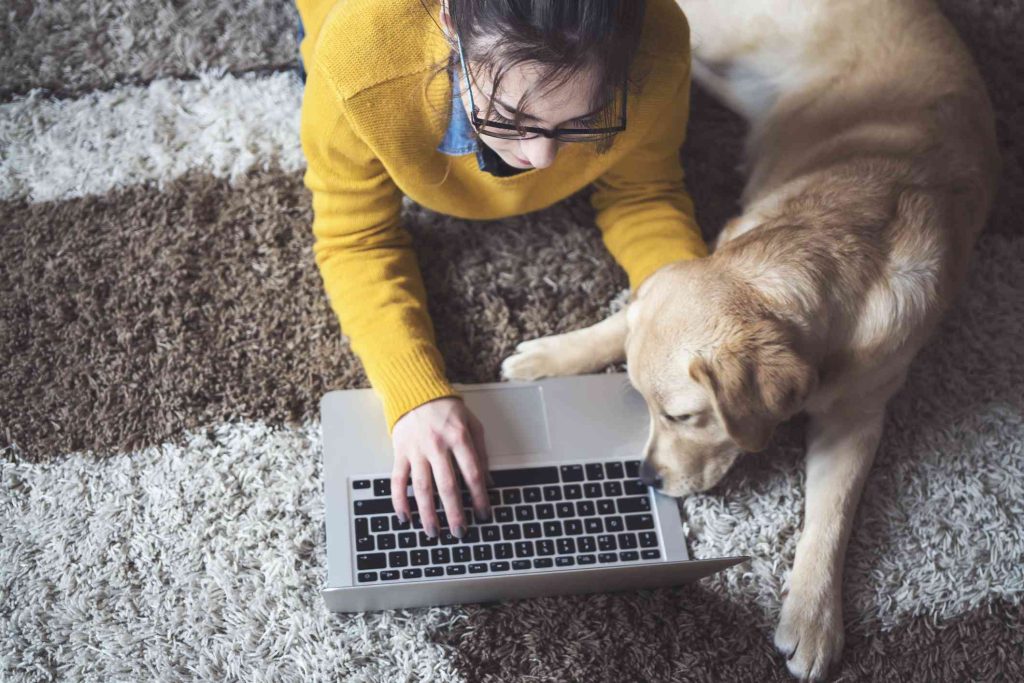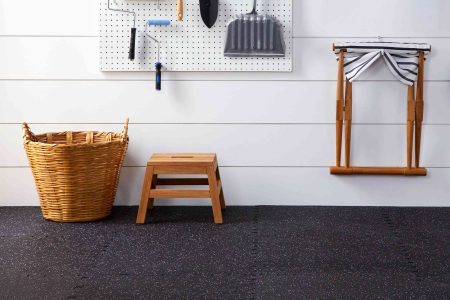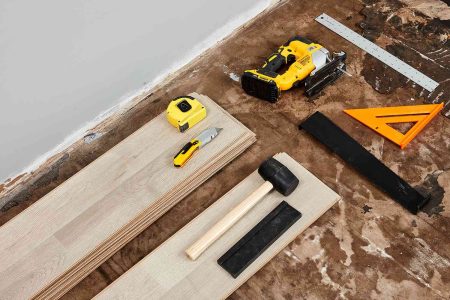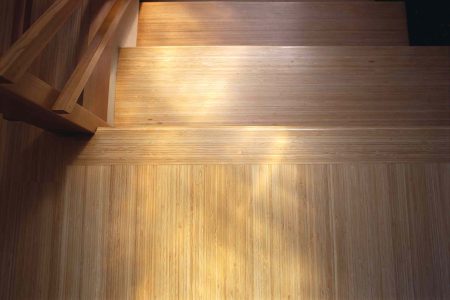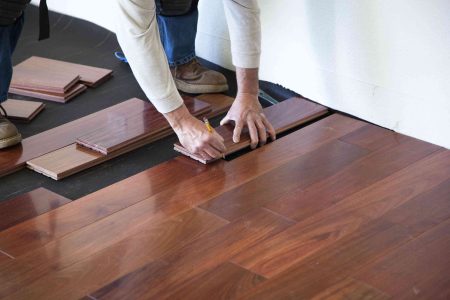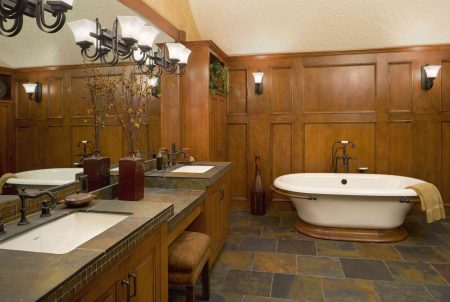In general, a good flooring material for dogs will offer a combination of scratch resistance, sound absorption, and cleanability. If you are in the process of remodeling your home and have a dog, now is the time to find a better and more durable flooring that’s pet-friendly. Of course, different dog breeds and individual animals place different demands on a floor (a young, rambunctious Shetland sheep dog is a much different pet than a mature sleepy bulldog). Your dog may also appreciate a floor that offers traction that helps it avoid slipping.
Here are 7 different types of flooring materials and an evaluation of how they will fare if your home has a pooch.
| Flooring Material | Pros | Cons | Dog-Friendliness Grade |
| Vinyl | Easy to clean, waterproof, stainproof, inexpensive | Can be gouged and scratched by toenails | A |
| Plastic laminate | Fairly resistant to scratches, easy to clean | Liquids can seep through cracks, slippery for active dogs | B |
| Bamboo | Very hard and resistant to scratches | Liquids can seep through cracks. | A-minus |
| Ceramic/porcelain tile | Easy to clean, some dogs like cool surface | Slippery for active dogs, may be too cold for aging dogs | A-minus |
| Carpet | Very comfortable and soft, deadens sound | “Accidents” are hard to eradicate, holds odors | D |
| Solid hardwood | Good for less active pets | Prone to scratches, liquids can seep down between boards | B |
| Engineered hardwood | Cheaper than solid hardwood, good for less active pets | Prone to scratches, delalmination; liquids can seep down to underlayment | C |
-
01
of 07Vinyl Flooring
- Best for: Any dog, especially those prone to accidents.
Vinyl flooring is arguably the best of all flooring materials for homes with pets. Vinyl is one of the easiest of all materials to clean, making it ideal for young or old pets prone to indoor accidents. And there is an almost infinite variety of patterns available. It is economical, which makes it easy to replace should your pet damage it.
Your dog will also love the cool surface during the summer and the warmth during the winter. Most importantly, your dog’s slick pads and claws won’t ice-skate across vinyl flooring. The material has just enough grip for your dog to feel comfortable and safe when trotting across the surface.
But be aware that active dogs with untrimmed toenails can still damage most forms of vinyl flooring, especially sheet vinyl. And luxury vinyl flooring does have seams. While the material itself is impervious to stains, it’s possible for liquids to seep down to the underlayment.
-
02
of 07Plastic Laminate Flooring
- Best for: Any moderately active dog that is well house-trained.
You may be surprised to learn that laminate can excel when it comes to scratch resistance. It is easy to determine how well a prospective laminate can resist scratches by checking out the specs section of the product description. Abrasion Class (AC) Ratings go from AC 1 to AC 5:
- A floor rated AC 1 and AC 2 may be too light and not well suited for dogs.
- A floor rated AC 3 stands up well in a room with moderate traffic and it’s dog-friendly.
- Floors rated above AC 3 are designed for use in commercial settings; though they’ll resist scratches, you may not find as many design options.
That said, don’t expect any laminate floor to be entirely impervious to damage from the toenails of a very active dog that likes to race around the house. And remember that laminate floors are slippery; a racing hound may well loose its traction and go careening into tables or floor lamps.
While laminate surfaces are fairly impervious to stains and are easy to clean, spills and liquid “accidents” can seep down between the cracks to soak into the underlayment—where odors are almost impossible to eradicate. Unless cleaned up immediately, water or urine can badly damage laminate flooring if it seeps down between planks.
-
03
of 07Bamboo Flooring
- Best for: Any moderately active dog that is well house-trained.
Bamboo flooring is often considered a wood flooring although the organic material is actually a type of grass. Some types of bamboo flooring, specifically strand-woven bamboo, is off the charts in terms of durability on the Janka flooring hardness scale. The hardness comes from the infusion of resins during the production of the flooring. Thus, bamboo is generally a much better choice than hardwood for flooring in a home with a dog. Your dog will like the inherent warmth of bamboo during the cold months; there is little need to install radiant heating, though bamboo does allow for it.
While it is still possible for dogs to scratch bamboo, it holds up better than most hardwood floors. But while bamboo floors are relatively easy to clean, it’s possible for liquids to seep down through cracks between boards, soaking into the underlayment. Keeping the floors well-sealed will help prevent this.
-
04
of 07Ceramic/Porcelain Tile
- Best for: Young, healthy dogs that like cool surfaces; dogs with questionable house-training habits.
Ceramic and porcelain floor tile certainly wipe down easily (think muddy paw prints). Unlike water-averse laminate, tile holds up under wet mop cleanups. Because tile has a cement board underlayment, there are no hollow spots that will echo the click-clacking of your dog’s claws. If grout lines are well-maintained, this flooring is almost impervious to damage from pets.
Consider using epoxy grout on your new tile floor. Its up-front cost is higher than that of traditional grouts, but you may save money on grout repair in the long run. Epoxy grout is particularly good at keeping stains and surface scratches to a minimum.
Remember that ceramic and porcelain tile is generally a cool surface unless it is installed over a radiant heating system. The coolness of tile can be much appreciated by dogs in warmer climates, but in the North, it may cause older dogs to experience arthritic pain.
Continue to 5 of 7 below. -
05
of 07Carpeting
- Best for: Dogs that are impeccably house-trained; older dogs with joint pain issues.
You and your dog will both love carpeting for its warmth and softness, and you’ll also appreciate its sound-deadening quality. And active dogs will never slip on carpeted floors. An older dog will find carpeted floors immensely comfortable for its aging joints.
That ends the list of advantages, though, as you will likely find yourself vacuuming up pet hair on a daily basis. And cleaning up after incontinent younger or older dogs is a genuine nightmare on a carpeted floor. Once urine seeps down into padding and underlayment, odors are very hard to eradicate.
If you do choose to carpet, look for a dense, cut-pile version. Looped fiber carpets are readily snagged by pet claws and will quickly develop a shabby look. Always opt for synthetic fibers, such as nylon or Triexta, which will be much easier to clean than natural fibers such as wool or cotton.
.
-
06
of 07Solid Hardwood
- Best for: Dogs with short, well-trimmed toenails
Solid hardwood flooring refers to flooring materials in which the planks are solid hardwood throughout their thickness. You love hardwood’s beauty and your dog will love hardwood’s relative warmth when compared to other hard flooring surfaces, such as ceramic tile. But your dog’s claws will likely end up scratching solid hardwood—not all species are equally hard. Harder woods such as ipe and hard maple are expensive, but it’s worth the expense when you consider how easily oak can be scratched by a dog with long, sharp claws.
Solid hardwood floors can be sanded down to refurbish them, but generally, this can be done only two or three times over the lifetime of the floor. And don’t expect sanding to erase the deepest claw scratches, or to eliminate water or urine stains that have penetrated deep into the wood.
If you choose solid hardwood for flooring, make sure to keep it well sealed with a good, hard polyurethane varnish. Lightly abrading and then recoating the floors every few years will minimize pet damage.
-
07
of 07Engineered Wood
- Best for: Dogs with short, well-trimmed toenails
Engineered wood refers to flooring products in which genuine hardwood comprises just a surface layer bonded to a core of fibrous particleboard or plywood. This flooring does a good job of mimicking the elegance of hardwood at a reasonable cost.
But a couple of years after installation, your dog may create deep scratches on the floor and you’ll need to contact a flooring pro to lightly sand and fix the problem. Your dog will find engineered wood to be as warm and comfortable as solid hardwood but don’t expect these floors to hold up as well as other hard-surface flooring materials. As with solid hardwood, you can minimize pet damage by keeping engineered wood floors protected with a fresh finish applied every few years.
How to Choose Dog-Friendly Flooring
Choosing the “best” flooring for a home with dogs depends on whose perspective is being considered. Your dog might find the comfort and warmth of carpet to be marvelous, but as a homeowner, you’re likely to find carpet a rather bad choice due to the constant cleaning and susceptibility to stains and odors. Here are some things to keep in mind:
- Level of house-training: Well-trained, healthy dogs can adapt to almost any flooring, but dogs prone to incontinence require flooring with few or no seams, made from materials that are easy to clean and resistant to stains. Such animals will do best on ceramic/porcelain tile or vinyl floors.
- Activity level: Extremely active dogs are likely to race around the house and will almost certainly be slipping and sliding on hard, glossy floors—making plenty of noise as they do it. A floor with some texture will be safer for everyone concerned. Carpet or embossed vinyl are good choices for dogs that like to run indoors.
- Age and health: Older dogs and those with joint issues will appreciate carpet, hardwood, or bamboo floors, which are inherently warm and softer than ceramic tile or laminate flooring. These are good choices if your pet’s comfort is a primary concern.
”
Read the full article here



